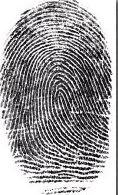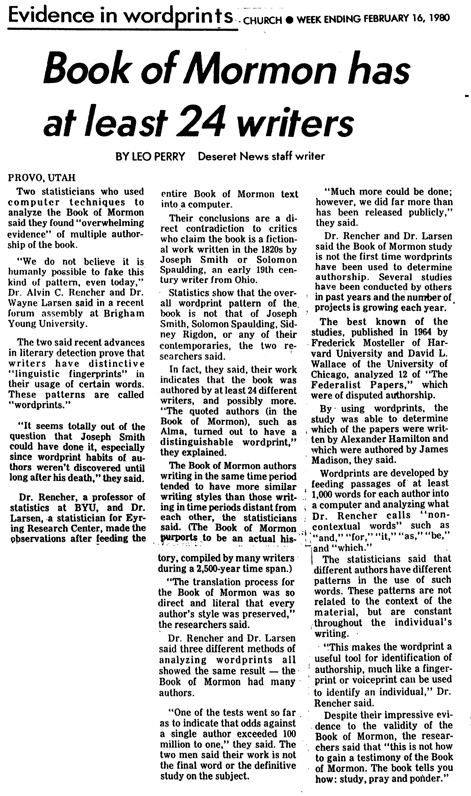Wordprints
Wordprints provide us evidence that there is "at least 24 writers" in the Book of Mormon.
These authors had a Hebrew or Semitic ancestral background.
The Book of Mormon original authors left evidence of word structure, style, expressions and phrases that their cultural heritage and language background was of a "Hebrew" or "Semitic" ancestry.
The following evidence indicates that the Book of Mormon could in no way have been authored by Joseph Smith, Sidney Rigdon, Oliver Cowdery, Solomon Spaulding, or anyone else living in the United States in the 1800's A.D. [Semitic languages include Syrian, Hebrew, ancient Egyptian, Arabic, and Aramaic.]
---------------------
 Wordprints are like unto Fingerprints.
Wordprints are like unto Fingerprints.No two fingerprints are alike.
"...the first written suggestions that something like wordprinting might be useful in objectively identifying authors appeared at least as early as 1851. Yet, because of the complexity of the measurements, the first credible studies had to await the availability of modern computers with their precise counting accuracy and high-speed computation." (BYU Studies)
----------------------Question:
What are “Wordprints”?
What do they have to do with the Book of Mormon?
Answer:
Wordprinting, or "stylometry" as it is more commonly known, is the science of measuring literary style. The main assumption underlying stylometry is that an author has aspects of literary style that may be unconsciously used, and can be used to identify their work. Stylometrists analyze literature using statistics, math formulas and artificial intelligence to determine the "style" of an author's writing.
Because authors may write on a variety of topics, the vocabulary they use may vary considerably. Researchers often attempt to use "non-contextual words" in their analyses to avoid this problem: patterns in the use of these words (e.g. such as: and, if, the, etc.) will be less influenced by a change in subject matter.
-------------------------------------------------------------------------
 Wordprints in the Book of Mormon indicate that there are "at least 24 authors".
Wordprints in the Book of Mormon indicate that there are "at least 24 authors".
The initial Book of Mormon wordprint studies were carried out by Larsen, Rencher, and Layton. They compared twenty-four Book of Mormon authors (each having at least 1,000 words) to each other, and concluded on the basis of three separate statistical tests that these authors were distinct from each other and Oliver Cowdery, Joseph Smith, Jr., and Solomon Spaulding.
---------------------------------------------------
A study done by;
John Hilton and the Berkeley Group
A more sophisticated approach was taken by John Hilton and non-LDS colleagues at Berkeley. The "Berkeley Group's" method relied on non-contextual word patterns, rather than just individual words. This more conservative method was designed from the ground up, and required works of at least 5,000 words.
The Berkeley Group first used a variety of control tests with non-disputed authors (e.g. works by Mark Twain, and translated works from German) in an effort to:
demonstrate the persistence of wordprints despite an author's effort to write as a different 'character'
demonstrate that wordprints were not obliterated by translation (e.g. two different authors rendered by the same translator would still have different wordprints).
The Berkeley Group's methods have since passed peer review, and were used to identify previously unknown writings written by Thomas Hobbes.
The Berkeley Group compared Book of Mormon texts written by Nephi and Alma with themselves, with each other, and with work by Joseph, Oliver, and Solomon Spaulding. Each comparison is assessed based upon the number of "rejections" provided by the model. The greater the number of rejections, the greater the chance that the two texts were not written by the same author. Tests with non-disputed texts showed that two texts by the same author never scored more than 6 rejections; thus, one cannot be certain if scores between 1–6 were written by the same or different authors. Scores of 0 rejections makes it statistically likely the two texts were written by the same author.
However, seven or more rejections indicates that the texts were written by a different author with a high degree of probability:
# of Rejections Certainty of being
different authors
7 99.5%
8 99.9%
9 99.99%
10 99.997%
Results: The results are striking:
Recall that any test over 6 indicates different authorship; 1–6 or less is indeterminate; 0 is same author. Each x represents one test
Furthermore, each "rejection" is statistically independent—this means that the chance of two different authors being the product the same person can be determined by multiplying the chance of each individual failure.
Thus the chance of Nephi and Alma being the same author is found by:
chance of 7 rejections x 8 rejections x 9 rejections x 10 rejections
= 0.005 x 0.001 x 0.0001 x 0.00003
= 0.000000000000015
=1.5 x 10-14
This is a roughly 1 in 15 trillion chance of Nephi and Alma having the same author.
Authors Cumulative chance of being the same author
Nephi and Alma 1.5 x 10-14
Joseph Smith and Alma 2.5 x 10-5
Joseph Smith and Nephi less than 2.7 x 10-20
Oliver Cowdery and Alma 6.25 x 10-17
Oliver Cowdery and Nephi less than 8.1 x 10-19
Spaulding and Alma less than 3 x 10-11
Spaulding and Nephi less than 7.29 x 10-28
Conclusion:
As John Hilton put the matter, if wordprinting is a valid technique, then this analysis suggests that it is statistically [defenseless] to claim that Joseph Smith, Oliver Cowdery, or Solomon Spaulding wrote the 30,000 words in the Book of Mormon attributed to Nephi and Alma.
The Book of Mormon contains work written by more than one author. Those authors were not Joseph Smith, Oliver Cowdery, or Solomon Spaulding.
----------------------
Source & Additional Information.
... What Can Stylometry Tell Us about the Book of Mormon Authorship? #389
... Is it Possiable that a Single Auther Wrote the Book of Mormon? #399
Wordprints and The Book of Mormon (Neal A. Maxwell Institute, By: John L. Hilton, Chapter 9)
Wordprints and The Book of Mormon (Neal A. Maxwell Institute, By: John L. Hilton, Chapter 64)
Stylometry and The Book of Mormon (FairMormon FAIR-Cast, Faith and Reason 12, Released 7/17/14) 7:43 min.
Book of Mormon/Wordprints studies (FairMormon)